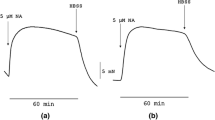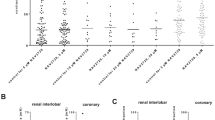Abstract
We investigated the features of swine lingual artery contraction induced with different strengths of stimulation. Endothelium-denuded artery rings were contracted with two concentrations of KCl, noradrenaline, and histamine with or without Y-27632, sodium nitroprusside (SNP), 2,2-diphenyl-1,3,2-oxaza-borolidine internal salt (2-APB), and extracellular Ca2+. While stored at 5°C up to 3 days, artery rings remained active to strong stimulation but became inactive to weak stimulation if prior warming was lacking. Artery rings contracted slowly and progressively to weak stimulation but rapidly to strong stimulation and then kept a plateau or slightly relaxed. Y-27632, SNP, and 2-APB, irrespective of extracellular Ca2+, attenuated weak-stimulation-induced contractions to much greater extents except that 2-APB similarly diminished contractions to both noradrenaline concentrations. Without extracellular Ca2+, transitory contractions occurred with one peak to strong stimulation and two small peaks to weak stimulation, though one full peak to both noradrenaline concentrations. Artery rings lost stimulant responsiveness when extracellular Ca2+ was absent, but subsequent Ca2+ reintroduction without coexisting stimulant triggered transient contractions, which were as large as contractions to weak stimulation with extracellular Ca2+ and ceased with Y-27632, SNP, and 2-APB. These results collectively suggest that, in the lingual artery, its contraction properties shift coupling with strengths of both receptor- and voltage-mediated stimulation, with the tonic-like component being dominant in weak-stimulation-induced contraction.








Similar content being viewed by others
References
Archer SL (1996) Diversity of phenotype and function of vascular smooth muscle cells. J Lab Clin Med 127:524–529
Bootman MD, Collins TJ, Mackenzie L, Roderick HL, Berridge MJ, Peppiatt CM (2002) 2-Aminoethoxydiphenyl borate (2-APB) is a reliable blocker of store-operated Ca2+ entry but an inconsistent inhibitor of InsP3-induced Ca2+ release. FASEB J 16:1145–1150
Clapham DE, Runnels LW, Strübing C (2001) The TRP ion channel family. Nat Rev Neurosci 2:387–396
del Valle-Rodríguez A, Lópes-Barneo J, Ureña J (2003) Ca2+ channel-sarcoplasmic reticulum coupling: a mechanism of arterial myocyte contraction without Ca2+ influx. EMBO J 22:4337–4345
Hanks JH, Wallace RE (1949) Relation of oxygen and temperature in the preservation of tissues by refrigeration. Proc Soc Exp Biol Med 71:196–200
Harker CT, Vanhoutte PM (1988) Cooling the central ear artery of the rabbit: myogenic and adrenergic responses. J Pharmacol Exp Ther 245:89–93
Harnett KM, Cao W, Biancani P (2005) Signal-transduction pathways that regulate smooth muscle function. I. Signal transduction in phasic (esophageal) and tonic (gastroesophageal sphincter) smooth muscles. Am J Physiol Gastrointest Liver Physiol 288:G407–G416
Hu H-Z, Gu Q, Wang C, Colton CK, Tang J, Kinoshita-Kawada M, Lee L-Y, Wood JD, Zhu MX (2004) 2-Aminoethoxydiphenyl borate is a common activator of TRPV1, TRPV2, and TRPV3. J Biol Chem 279:35741–35748
Janiak R, Wilson SM, Montague S, Hume JR (2001) Heterogeneity of calcium stores and elementary release events in canine pulmonary arterial smooth muscle cells. Am J Physiol Cell Physiol 280:C22–C33
Kobayashi S, Kanaide H, Nakamura M (1986) Complete overlap of caffeine- and K+ depolarization-sensitive intracellular calcium storage site in cultured rat arterial smooth muscle cells. J Biol Chem 261:15709–15713
Long W, Zhang L, Longo LD (2000) Cerebral artery sarcoplasmic reticulum Ca2+ stores and contractility: changes with development. Am J Physiol Regulatory Integrative Comp Physiol 279:R860–R873
Majesky MW (2007) Developmental basis of vascular smooth muscle diversity. Arterioscler Thromb Vasc Biol 27:1248–1258
Maruyama T, Kanaji T, Nakade S, Kanno T, Mikoshiba K (1997) 2-Aminoethoxydiphenyl borate, a membrane-penetrable modulator of Ins(1, 4, 5)P3-induced Ca2+ release. J Biochem (Tokyo) 122:498–505
Matsumoto T, Kanaide H, Shogakiuchi Y, Nakamura M (1990) Characteristics of the histamine-sensitive calcium store in vascular smooth muscle. Comparison with norepinephrine- or caffeine-sensitive stores. J Biol Chem 265:5610–5616
McCarron JG, Craig JW, Bradley KN, Muir TC (2002) Agonist-induced phasic and tonic responses in smooth muscle are mediated by Ins P3. J Cell Sci 115:2207–2218
Mita M, Yanagihara H, Hishinuma S, Saito M, Walsh MP (2002) Membrane depolarization-induced contraction of rat caudal arterial smooth muscle involves Rho-associated kinase. Biochem J 364:431–440
Münzel T, Feil R, Mülsch A, Lohmann SM, Hofmann F, Walter U (2003) Physiology and pathophysiology of vascular signaling controlled by guanosine 3', 5'-cyclic monophosphate-dependent protein kinase. Circulation 108:2172–2183
Narumiya S, Ishizaki T, Uehata M (2000) Use and properties of ROCK-specific inhibitor Y-27632. Methods Enzymol 325:273–284
Ogut O, Brozovich FV (2003) Regulation of force in vascular smooth muscle. J Mol Cell Cardiol 35:347–355
Patel CA, Rattan S (2006) Spontaneously tonic smooth muscle has characteristically higher levels of RhoA/ROK compared with the phasic smooth muscle. Am J Physiol Gastrointest Liver Physiol 291:G830–G837
Ratz PH, Berg KM, Urban NH, Miner AS (2005) Regulation of smooth muscle calcium sensitivity: KCl as a calcium-sensitizing stimulus. Am J Physiol Cell Physiol 288:C769–C783
Sakurada S, Takuwa N, Sugimoto N, Wang Y, Seto M, Sasaki Y, Takuwa Y (2003) Ca2+-dependent activation of Rho and Rho kinase in membrane depolarization-induced and receptor stimulation-induced vascular smooth muscle contraction. Circ Res 93:548–556
Somlyo AP, Somlyo AV (2003) Ca2+ sensitivity of smooth muscle and nonmuscle myosin II: modulated by G proteins, kinases, and myosin phosphatase. Physiol Rev 83:1325–1358
Sward K, Dreja K, Susnjar M, Hellstrand P, Hartshorne DJ, Walsh MP (2000) Inhibition of Rho-associated kinase blocks agonist-induced Ca2+ sensitization of myosin phosphorylation and force in guinea-pig ileum. J Physiol 522:33–49
Uehata M, Ishizaki T, Satoh H, Ono T, Kawahara T, Morishita T, Tamakawa H, Yamagami K, Inui J, Maekawa M, Narumiya S (1997) Calcium sensitization of smooth muscle mediated by a Rho-associated protein kinase in hypertension. Nature 389:990–994
Urban NH, Berg KM, Ratz PH (2003) K + depolarization induces RhoA kinase translocation to caveolae and Ca2+ sensitization of arterial muscle. Am J Physiol Cell Physiol 285:C1377–C1385
Ureña J, Smani T, López-Barneo J (2004) Differential functional properties of Ca2+ stores in pulmonary arterial conduit and resistance myocytes. Cell Calcium 36:525–534
Winquist RJ, Bevan JA (1980) Temperature sensitivity of tone in the rabbit facial vein: myogenic mechanism for cranial thermoregulation? Science 207:1001–1002
Acknowledgements
We thank H Nakajima and N Mori for their help in preparing figures.
Author information
Authors and Affiliations
Corresponding author
Electronic supplementary material
Below is the link to the electronic supplementary material.
Fig9
Representative traces of ratio of fluorescence at 340 nm (F340) to fluorescence at 380 nm (F380), which indicate changes in intracellular Ca2+ concentration synchronizing with stimulation in the presence and absence of perfusate Ca2+. (GIF 35 KB)
Rights and permissions
About this article
Cite this article
Kawaguchi, T., Satoh, Ki., Kuji, A. et al. Features of distinct contractions induced with a high and a low concentration of KCl, noradrenaline, and histamine in swine lingual artery. Naunyn-Schmied Arch Pharmacol 381, 107–120 (2010). https://doi.org/10.1007/s00210-009-0486-9
Received:
Accepted:
Published:
Issue Date:
DOI: https://doi.org/10.1007/s00210-009-0486-9




